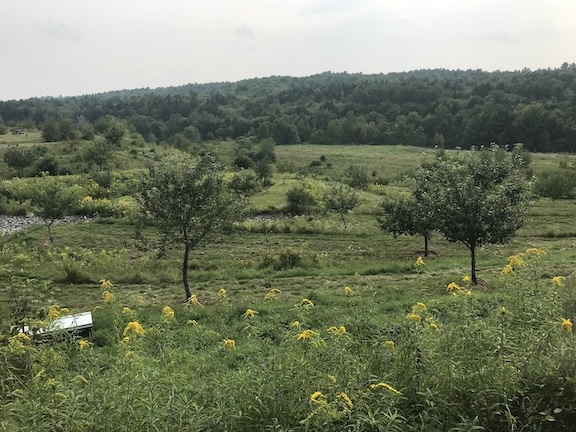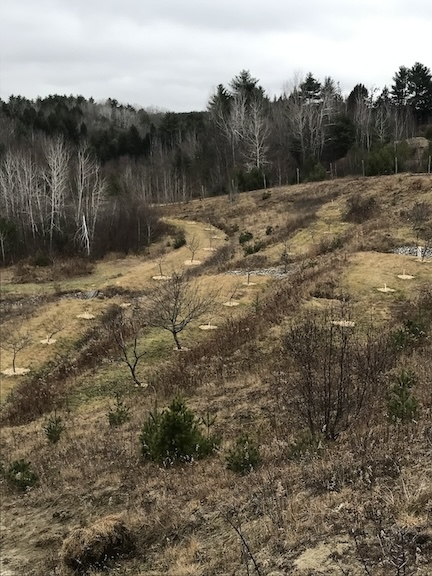By C.J. Walke, MOFGA’s Orchard Program Manager
As we move into 2025, the Maine Heritage Orchard, MOFGA’s 10-acre preservation and educational orchard, is well rooted in the reclaimed soils of a former gravel pit. Terraces constructed to hold back steep eroding slopes have stabilized and are home to nearly half the orchard’s apple trees, with dozens of native plant species interplanted between the terraces to further stabilize and rebuild the previously worn-out soils. The remaining apples and pears are planted along two long rows at the top of the orchard overlooking the steep bank to the settling pond below, as well as along a gentler south-facing slope that levels out at its base.
Our fruit trees are grafted onto cold-hardy standard rootstocks (Malus‘Antonovka’ and Pyrus ‘OHxF97’), meaning they are free-standing, well-rooted, long-lived trees that will likely outlive any of us who visit the orchard today. With continued support and dedication, the trees will stand for many future generations to stroll through the rows, swing from a branch, and taste the history, stories, and memories held within the ripe fruits.

Most of these 300-plus rare apple varieties were planted over the course of a few years — roughly 100 trees a year, including 20 total heritage pear varieties — as passionate volunteers helped establish the orchard, setting its roots and making a commitment for the future. Looking back, we have overcome many challenges and have achieved great success at preserving varieties that could have easily slipped into extinction. Our dedication to preserving these rare varieties is unwavering. As the trees start to mature and reach their early bearing years, we are preparing to harvest the fruits of our collective labors.
During the past few years, we have seen some of the oldest trees start to bear a modest amount of fruit, despite fluctuations between drought years and wet years, freezing temperatures during bloom, and 95-plus degrees in early June as fruitlets were setting. Resilience is inherent in these heritage varieties: Varieties rediscovered on abandoned farms or near overgrown stone walls have survived centuries, regardless of extreme weather or vigilant pests or varying levels of human interaction. Their resilience inspires us to continue our commitment, regardless of challenges.
Preparing for the Next Decade
For the coming decade, we anticipate a gradual shift in the seasonal tasks that make up our daily work in the Maine Heritage Orchard. Newly planted trees have always been kept weed-free around the base, with compost and ramial wood chips added around the trunk (not up the trunk!) to build organic matter, retain moisture, and establish a solid, well-anchored root system, in addition to weed suppression. As those trees start to reach 8-10 inches in diameter at the base, we are shifting focus away from the trunk and towards the drip line of the trees, gradually improving the soil ahead of the trees, as their roots reach further and further each year.
This past fall as we prepared the trees for winter, we decided to not put vole guards around some of these larger-diameter trees. We use spiral guards around the young trees, then shift to window screen, tied with twine, as the trunks get too large for the spiral guards to fit properly. As the trees grow larger, the bark gets tougher and flakey, and the voles don’t seem to be very interested in gnawing on these older trees. So, for the first time, we left a few dozen unwrapped for the winter. Hopefully we don’t regret this decision, but to date no damage has been done.
Winter pruning is a task that has been increasing significantly in recent years as the trees mature and require more individual attention. We typically start pruning during the first week of January with the goal of completing all trees before the end of March. As this annual task intensifies, we may seek more help from our dedicated heritage orchard community. Maybe we’ll host an in-depth pruning school or regular pruning club in the future? We are still ruminating on this.

The biggest anticipated shift in the coming years will be at harvest time. By mid-August, over a dozen summer varieties will be ripe and ready to pick, and harvest season will continue through the fall — and possibly into the first week of November in some years. Previously, we continued to weed, compost, and mulch into November to get to all the trees. Now harvesting is becoming an all-encompassing task for our small orchard crew of one and a half full-time staff. It takes a lot of time to pick, sort, grade, and store fruit for each distinct variety. And we have over 300 varieties.
Our operations and infrastructure are slowly rising to meet the demands of our growing orchard needs. Our year-round orchard crew has increased slightly. Our stash of pruning tools has expanded, especially in the pole saw category to reach further into the larger trees. We’ve started building more bushel boxes to harvest and store fruit. We are in the process of acquiring a second donated cider press to squeeze marginal-quality fruit into sweet cider. We are exploring options to establish irrigation in the orchard. And we’ve begun the construction of a 24-by-24-foot orchard shed that will house our equipment and tools, and also provide a central hub for orchard activities.
The Maine Heritage Orchard would not exist without the passion, commitment, and dedication of numerous volunteers, some who no longer walk the earth, and we are deeply grateful for their work. We have a strong group of collaborative orchards and nurseries who help graft, grow, evaluate, and distribute the heritage varieties we strive to preserve. Our continued success depends upon continued support from our passionate community of hardworking volunteers and donors. We welcome you into the Maine Heritage Orchard and thank you for your commitment.
This article originally appeared in the spring 2025 issue of The Maine Organic Farmer & Gardener.
